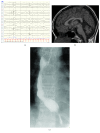Inherited Paediatric Motor Neuron Disorders: Beyond Spinal Muscular Atrophy
- PMID: 28634552
- PMCID: PMC5467325
- DOI: 10.1155/2017/6509493
Inherited Paediatric Motor Neuron Disorders: Beyond Spinal Muscular Atrophy
Abstract
Paediatric motor neuron diseases encompass a group of neurodegenerative diseases characterised by the onset of muscle weakness and atrophy before the age of 18 years, attributable to motor neuron loss across various neuronal networks in the brain and spinal cord. While the genetic underpinnings are diverse, advances in next generation sequencing have transformed diagnostic paradigms. This has reinforced the clinical phenotyping and molecular genetic expertise required to navigate the complexities of such diagnoses. In turn, improved genetic technology and subsequent gene identification have enabled further insights into the mechanisms of motor neuron degeneration and how these diseases form part of a neurodegenerative disorder spectrum. Common pathophysiologies include abnormalities in axonal architecture and function, RNA processing, and protein quality control. This review incorporates an overview of the clinical manifestations, genetics, and pathophysiology of inherited paediatric motor neuron disorders beyond classic SMN1-related spinal muscular atrophy and describes recent advances in next generation sequencing and its clinical application. Specific disease-modifying treatment is becoming a clinical reality in some disorders of the motor neuron highlighting the importance of a timely and specific diagnosis.
Figures




Similar articles
-
X-linked spinal muscular atrophy in mice caused by autonomous loss of ATP7A in the motor neuron.J Pathol. 2015 Jun;236(2):241-50. doi: 10.1002/path.4511. Epub 2015 Mar 3. J Pathol. 2015. PMID: 25639447 Free PMC article.
-
Update on Inherited Pediatric Motor Neuron Diseases: Clinical Features and Outcome.Genes (Basel). 2024 Oct 21;15(10):1346. doi: 10.3390/genes15101346. Genes (Basel). 2024. PMID: 39457470 Free PMC article. Review.
-
Investigation of the role of SMN1 and SMN2 haploinsufficiency as a risk factor for Hirayama's disease: clinical, neurophysiological and genetic characteristics in a Spanish series of 13 patients.Clin Neurol Neurosurg. 2007 Dec;109(10):844-8. doi: 10.1016/j.clineuro.2007.07.019. Epub 2007 Sep 11. Clin Neurol Neurosurg. 2007. PMID: 17850955
-
The Genetics of Spinal Muscular Atrophy: Progress and Challenges.Neurotherapeutics. 2015 Apr;12(2):290-302. doi: 10.1007/s13311-014-0314-x. Neurotherapeutics. 2015. PMID: 25413156 Free PMC article. Review.
-
Adult-onset spinal muscular atrophy: An update.Rev Neurol (Paris). 2017 May;173(5):308-319. doi: 10.1016/j.neurol.2017.03.015. Epub 2017 Apr 26. Rev Neurol (Paris). 2017. PMID: 28456383 Review.
Cited by
-
Neuromuscular Diseases and Bone.Front Endocrinol (Lausanne). 2019 Nov 22;10:794. doi: 10.3389/fendo.2019.00794. eCollection 2019. Front Endocrinol (Lausanne). 2019. PMID: 31824418 Free PMC article. Review.
-
The Anti-Inflammatory Effects and Mechanism of the Submerged Culture of Ophiocordyceps sinensis and Its Possible Active Compounds.J Fungi (Basel). 2024 Jul 27;10(8):523. doi: 10.3390/jof10080523. J Fungi (Basel). 2024. PMID: 39194849 Free PMC article.
-
Retrospective Diagnosis of Pontocerebellar Hypoplasia Type 1B in a Family with Two Deceased Newborn Children.J Pediatr Genet. 2020 Oct 8;11(3):253-256. doi: 10.1055/s-0040-1718536. eCollection 2022 Sep. J Pediatr Genet. 2020. PMID: 35990027 Free PMC article.
-
Association of TRMT2B gene variants with juvenile amyotrophic lateral sclerosis.Front Med. 2024 Feb;18(1):68-80. doi: 10.1007/s11684-023-1005-y. Epub 2023 Oct 24. Front Med. 2024. PMID: 37874476
-
Autophagy Modulation as a Treatment of Amyloid Diseases.Molecules. 2019 Sep 16;24(18):3372. doi: 10.3390/molecules24183372. Molecules. 2019. PMID: 31527516 Free PMC article. Review.
References
Publication types
MeSH terms
LinkOut - more resources
Full Text Sources
Other Literature Sources
Medical

